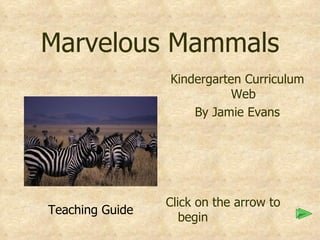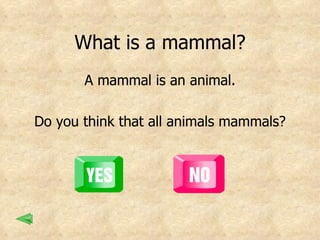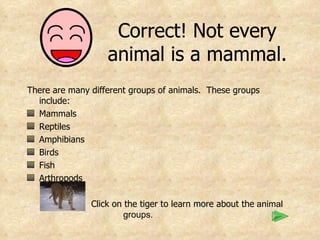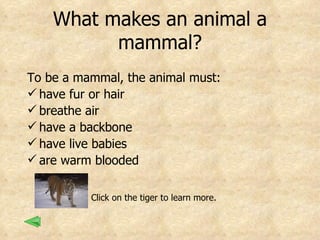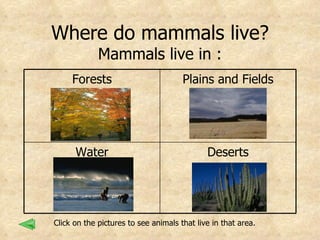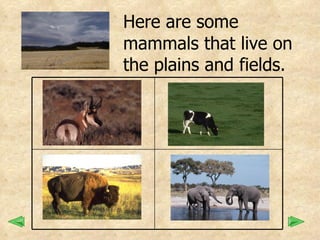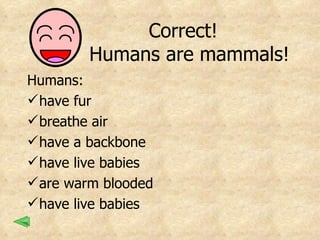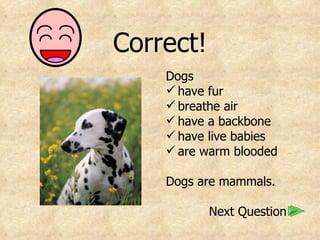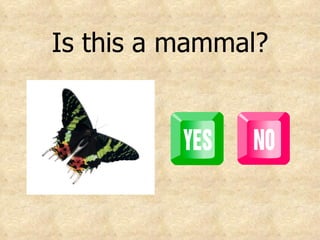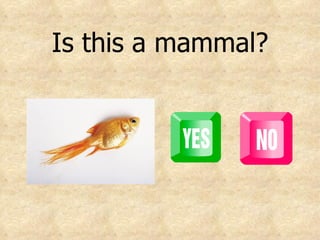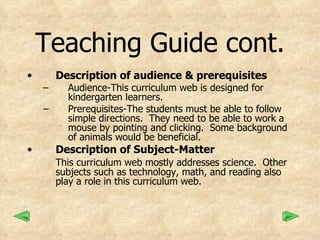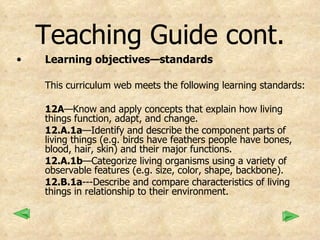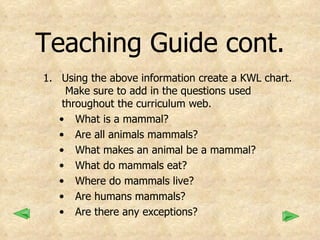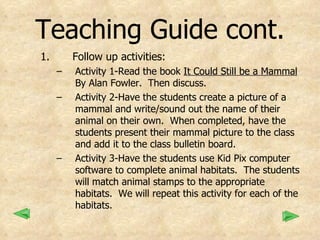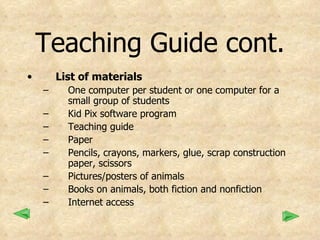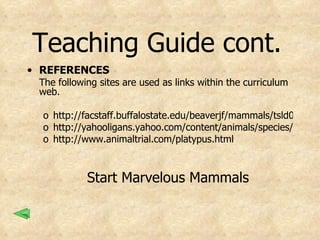Marvelous mammals plus
- 1. Marvelous Mammals Kindergarten Curriculum Web By Jamie Evans Click on the arrow to begin Teaching Guide
- 2. What is a mammal? A mammal is an animal. Do you think that all animals mammals?
- 4. Correct! Not every animal is a mammal. There are many different groups of animals. These groups include: Mammals Reptiles Amphibians Birds Fish Arthropods Click on the tiger to learn more about the animal groups.
- 5. What do we want to know about mammals? Click on each question below What makes an animal a mammal? What do mammals eat? Where do mammals live? Are humans mammals? Are there any exceptions?
- 6. What makes an animal a mammal? To be a mammal, the animal must: have fur or hair breathe air have a backbone have live babies are warm blooded Click on the tiger to learn more.
- 7. What do mammals eat? Like most animals, mammals eat many things like: meat plants both meat and plants baby mammals drink milk
- 8. Where do mammals live? Mammals live in : Click on the pictures to see animals that live in that area. Forests Plains and Fields Water Deserts
- 9. Are there any exceptions? Yes! Both the spiny anteater and the platypus are mammals, but they both lay eggs. spiny anteater platypus
- 10. Here are some mammals that live in the forest.
- 11. Here are some mammals that live on the plains and fields.
- 12. Here are some mammals that live in the water. ╠² ╠²╠²╠²╠²╠²╠²╠²╠²╠²╠²╠²╠²╠²╠²╠²╠²╠²╠²╠²╠²╠²╠²╠²╠²╠²╠² ╠² ╠²╠²╠²╠²╠²╠²╠²╠²╠²╠²╠²╠²╠²╠²╠²╠²╠²╠²╠²╠²╠²╠²╠²╠²╠²╠²
- 13. Here are some mammals that live in the dessert. ╠² ╠²╠²╠²╠²╠²╠²╠²╠²╠²╠²╠²╠²╠²╠²╠²╠²╠²╠²╠²╠²╠²╠²╠²╠²╠²╠² ╠² ╠²╠²╠²╠²╠²╠²╠²╠²╠²╠²╠²╠²╠²╠²╠²╠²╠²╠²╠²╠²╠²╠²╠²╠²╠²╠² ╠² ╠²╠²╠²╠²╠²╠²╠²╠²╠²╠²╠²╠²╠²╠²╠²╠²╠²╠²╠²╠²╠²╠²╠²╠²╠²╠²
- 14. What have you learned about Mammals so far? Can you identify mammals?
- 16. Correct! Humans are mammals! Humans: have fur breathe air have a backbone have live babies are warm blooded have live babies
- 18. Is this a mammal?
- 19. Correct! Cats have fur breathe air have a backbone have live babies are warm blooded Cats are mammals. Next Question
- 21. Is this a mammal?
- 22. Correct! Eagles do not have fur do not have live babies Eagles are not mammals. Next Question
- 24. Is this a mammal?
- 25. Correct! Dogs have fur breathe air have a backbone have live babies are warm blooded Dogs are mammals. Next Question
- 27. Is this a mammal?
- 28. Correct! Butterflies do not have fur do not have live babies do not have backbones are not warm blooded Butterflies are not mammals. Next Question
- 30. Is this a mammal?
- 31. Correct! Goldfish do not have fur do not have live babies do not have backbones are not warm blooded do not breathe air Goldfish are not mammals.
- 33. Congratulations! You have worked very hard. See your teacher for the next Mammal Mission. TeacherŌĆÖs Guide
- 34. Teaching Guide Introduction Throughout the year, our kindergarten science curriculum focuses on animals. We learn how they look, feel, act, and sound. We learn about where they live and what they eat. We learn about the different classifications of animals and their lifecycles. We also introduce an array of vocabulary that revolves around this topic. Aim The aim of this curriculum web is to give the students the opportunity to learn about and view one of animal classifications, mammals, that kindergarten studies throughout the year. Rationale The rationale is to allow the students to experience information about mammals in a different context.
- 35. Teaching Guide cont. Description of audience & prerequisites Audience-This curriculum web is designed for kindergarten learners. Prerequisites-The students must be able to follow simple directions. They need to be able to work a mouse by pointing and clicking. Some background of animals would be beneficial. Description of Subject-Matter This curriculum web mostly addresses science. Other subjects such as technology, math, and reading also play a role in this curriculum web.
- 36. Teaching Guide cont. Learning objectivesŌĆöstandards This curriculum web meets the following learning standards: 12A ŌĆöKnow and apply concepts that explain how living things function, adapt, and change. 12.A.1a ŌĆöIdentify and describe the component parts of living things (e.g. birds have feathers people have bones, blood, hair, skin) and their major functions. 12.A.1b ŌĆöCategorize living organisms using a variety of observable features (e.g. size, color, shape, backbone). 12.B.1a ---Describe and compare characteristics of living things in relationship to their environment.
- 37. Teaching Guide cont. Instructional plan As a class, make a list of animals. Compare the similarities and differences of the animals, use pictures if available. Introduce the term mammal. Discuss what the students believe a mammal is. Talk about possible examples. Try to figure out what they all have in common.
- 38. Teaching Guide cont. Using the above information create a KWL chart. Make sure to add in the questions used throughout the curriculum web. What is a mammal? Are all animals mammals? What makes an animal be a mammal? What do mammals eat? Where do mammals live? Are humans mammals? Are there any exceptions?
- 39. Teaching Guide cont. Begin a guided study of mammals using the curriculum web. Take the curriculum web one question at a time. Discuss the information and visit the websites included in the curriculum web as a class. After discussing all the questions, have the students individually take the curriculum web quiz found on the curriculum web.
- 40. Teaching Guide cont. Follow up activities: Activity 1-Read the book It Could Still be a Mammal By Alan Fowler. Then discuss. Activity 2-Have the students create a picture of a mammal and write/sound out the name of their animal on their own. When completed, have the students present their mammal picture to the class and add it to the class bulletin board. Activity 3-Have the students use Kid Pix computer software to complete animal habitats. The students will match animal stamps to the appropriate habitats. We will repeat this activity for each of the habitats.
- 41. Teaching Guide cont. List of materials One computer per student or one computer for a small group of students Kid Pix software program Teaching guide Paper Pencils, crayons, markers, glue, scrap construction paper, scissors Pictures/posters of animals Books on animals, both fiction and nonfiction Internet access
- 42. Teaching Guide cont. Plan for assessment and evaluation Self evaluation quiz on mammals Class participation in discussions and activities on mammals Have students use Kid Pix software program to classify mammals into the appropriate habitat Have students draw/create picture examples of a mammal
- 43. Teaching Guide cont. REFERENCES The following sites are used as links within the curriculum web. http://facstaff.buffalostate.edu/beaverjf/mammals/tsld002.htm http://yahooligans.yahoo.com/content/animals/species/3903.html http://www.animaltrial.com/platypus.html Start Marvelous Mammals

